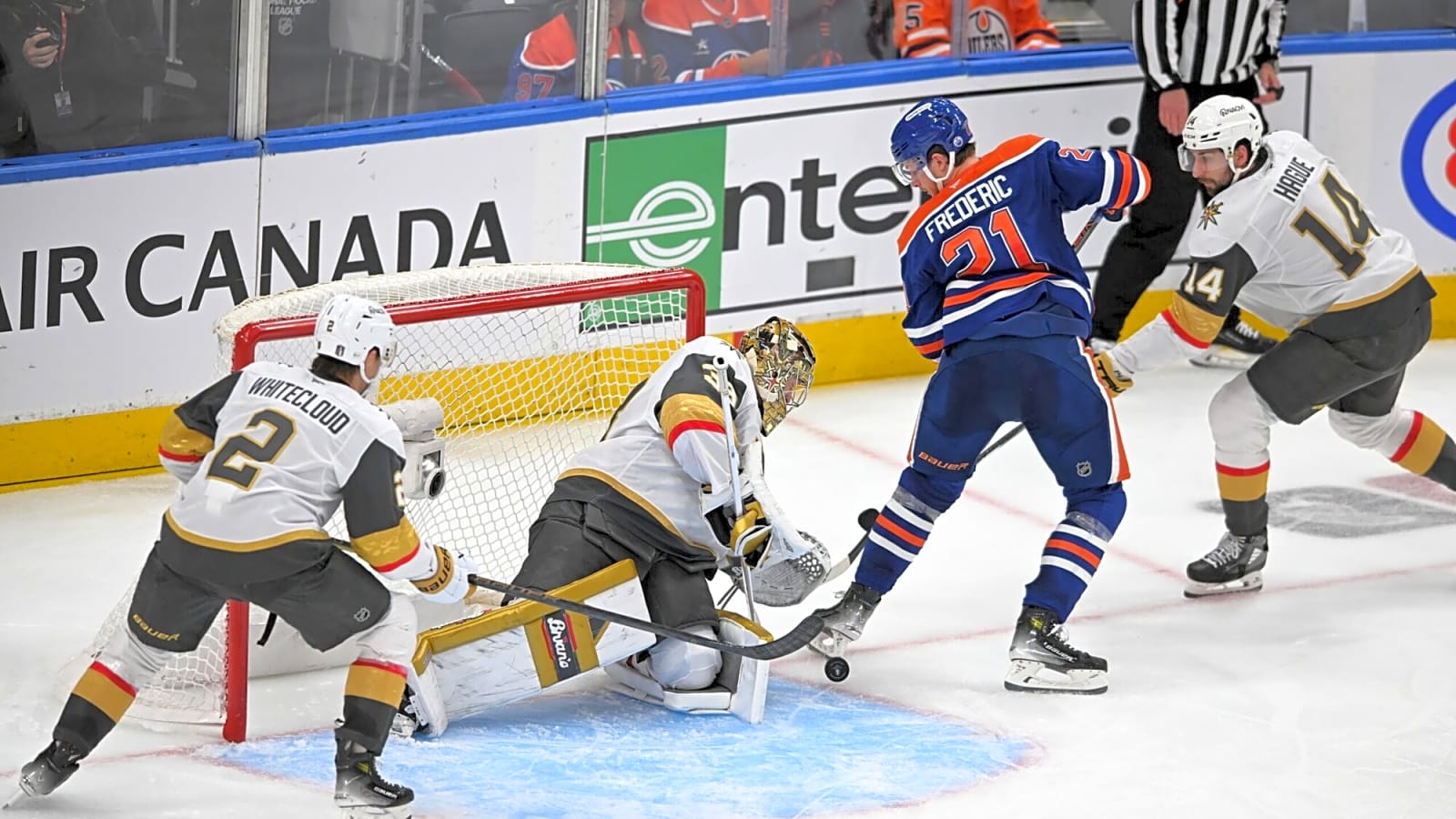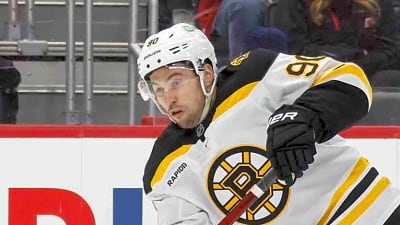
When the Oilers wrapped up their pre-game skate ahead of Game 4, one thing was immediately clear: bold moves and fresh line combinations would hit the ice. This shake-up was somewhat surprising, considering Edmonton held a 2-1 series lead and had just narrowly missed taking Game 3 to overtime by less than a second. But the coaching staff clearly saw an opportunity to elevate their team’s performance, and they weren’t afraid to act decisively.
Troy Stecher and Kasperi Kapanen stepped into the lineup, replacing Ty Emberson and Victor Arvidsson. Even more intriguing was the courageous call to put Leon Draisaitl on his own line alongside Vasily Podkolzin and surprise addition Kasperi Kapanen. On defence, Stecher reunited with his former partner Darnell Nurse, shifting Evan Bouchard alongside Brett Kulak and pairing Jake Walman with John Klingberg. These weren’t minor tweaks. They signalled the coaches’ determination to address key concerns head-on, despite their series advantage.
Did it pay off? Absolutely. Just as Bruce Cassidy’s strategic adjustments had powered Vegas to a critical Game 3 victory, the Oilers’ coaching duo of Kris Knoblauch and Paul Coffey deserve major credit for their bold moves ahead of Game 4.
In fact, their adjustments didn’t just work — they delivered a massive impact, vaulting Edmonton to a commanding 3-1 series lead heading back to Vegas.
Curious how these calculated gambles translated into a decisive win? Let’s roll the tape.
What Caught My Eye?
The New Second Line
Heading into this series, I thought the Oilers needed to split Draisaitl and McDavid by pairing Draisaitl with Nugent-Hopkins, creating two dynamic scoring threats. Well, the Oilers did split up their superstar duo, but the reason and execution completely surprised me.
Draisaitl appears to be playing through an undisclosed injury, although the team hasn’t confirmed anything. Clearly, he’s not his usual dominant self. Recognizing this, the coaching staff made a move: pairing him with bigger, faster linemates to handle more of the physical workload.
Did it pay off? Absolutely. Just look at a couple of standout shifts that highlight exactly why this combo worked.
In this first shift, watch how Kapanen’s blazing speed pushes the Vegas defence back, opening up valuable space behind him for Draisaitl to operate. There’s even some unintended excitement when Draisaitl’s shot hits Kapanen, but Podkolzin quickly steps up to take control.
Notice how Podkolzin positions himself perfectly as F3, allowing Evan Bouchard to aggressively pinch on the Vegas forward, before delivering not one but two momentum-building checks across 60 feet of ice.
This relentless physicality creates chaos, giving Draisaitl the chance to scoop up the loose puck. Podkolzin then circles back up the wall, picks up Draisaitl’s pass, and confidently generates a high-quality scoring opportunity. That’s the type of energy and execution that can turn a game around.
Now, let’s look at another shift that is in both the offensive and neutral zones. Again, Kapanen does the work to enter the zone instead of Draisaitl. Then watch the interplay of the three forwards. There is constant motion, which is very challenging for defenders.
The three were also great at creating loose pucks off stick checks as well. When the puck finally leaves the zone, look at the nice back pressure by Draisaitl and Podkolzin, which allows Troy Stecher to step up and blunt an attack against.
The biggest surprise about this line was who they played against. This line plays more against the Jack Eichel line than any other. They did it well, holding the Eichel line to one shot on the night. Eventually, Vegas had to shuffle that line to try and create offence. It did not work.
Whatever inspired the coaching staff to put this line together, it worked. Not only did it help Leon Draisaitl with some of the heavy lifting. The line was a deterrent to the best line Vegas has in this series.
The Evan Bouchard Experience
Evan Bouchard ended this game with only one assist and two shots on net. However, that hardly tells the tale of his night. He was quietly very effective all night. Of course, his assist was a great pass to McDavid to start the attack and very noticeable to everyone watching.
What I liked more was his overall play without the puck. Here is a shift early in this game where he defended counterattacks twice. Watch how he steps up on plays when he knows he has forward help coming back. In the first instance, he just slows the rush by forcing the Vegas player to go east-west before finally giving the puck up. Then on the second foray, he steps up and disrupts the play with a great hit ,sending the puck back in the zone.
When Vegas attacked, Bouchard looked very composed on the attack. Here was a great example. Watch how he keeps his body on the hip of the Vegas player, which prevents the cutback play behind him, but also allows Bouchard to defend the wide drive. The Vegas player tries to dangle through Bouchard, but he holds his position perfectly and defeats the attack.
Finally, Bouchard is known as a brilliant passer. We saw it on the goal by Evander Kane, but Bouchard had numerous other high-grade passes. Watch a couple here. In the first, we see Bouchard counter another attack in the neutral zone with his stick. He ends up with the puck going back into his zone. Now I have slowed this down. Watch Bouchard take a quick scan to see where everyone is on the ice. He makes his decision and then fires a great pass up ice.
My favourite pass was one that didn’t lead to a goal, but led to a great attack. It starts with him receiving the puck in a tough spot because Ryan Nugent-Hopkins turns into his space. Watch Bouchard’s patience in allowing Nugent-Hopkins to clear into a better spot. He does this by slowly moving up ice at an angle to allow separation. When complete, he makes a brilliant saucer pass to Nugent-Hopkins in great space and the attack is on.
Evan Bouchard is exactly why analytics matter in hockey. Yes, he can occasionally make noticeable mistakes that stick in your memory, overshadowing everything else. But what you might not see are the seven or eight other crucial plays he makes each game, plays that his teammates and coaches clearly recognize.
Last night, Bouchard erased any doubts. He avoided major errors and delivered an exceptional defensive performance away from the puck. He logged the most penalty-killing minutes of any Oilers defenseman, a smart and necessary move in the absence of Ty Emberson. With just one assist on the scoresheet, Bouchard still stood out as one of Edmonton’s strongest defenders in a dominant 3-0 victory. When Bouchard plays like this, the Oilers have found their winning formula.
The Forecheck Goals
The only disappointing aspect of Game 3 was the Oilers’ failure to capitalize against a clearly vulnerable Golden Knights defence. Brayden McNabb was noticeably struggling after crashing hard into the boards following Arvidsson’s trip, and Alex Pietrangelo didn’t look like his usual self either.
Given these weaknesses, combined with Vegas’ shaky third defensive pairing, I expected Edmonton to aggressively exploit the situation by relentlessly pressuring on the forecheck. Instead, I was surprised to see the Oilers not consistently putting pucks deep and making Vegas’ defenders pay the price.
Game 4, however, was a different story, and it was clear Edmonton made this adjustment a priority.
Right from the opening face-off goal by Adam Henrique, the Oilers showed a renewed commitment to forechecking. Watch Connor Brown immediately pressuring Vegas’ third pairing, forcing a hurried play and a turnover. Then Evander Kane steps up, delivering a perfectly timed, punishing check to ensure Vegas can’t recover possession. The puck squirts free right into the slot, where Henrique finishes the play beautifully from the ideal F3 position.
That’s how you attack a weakened defence — Decisively, relentlessly, and effectively.
The second goal was an even better example of the forecheck. Watch the great rotation of the forwards, always maintaining a structured F1-F2-F3. The physical nature of the play was also self-evident. In particular, Zach Hyman was a beast. Ultimately, this very disciplined and very hard forecheck leads to the second Henrique goal.
This happened against the McNabb – Theodore pairing. It is a pairing that I believe the Oilers need to attack more heavily because it can be exposed. On this night, the Oilers were much better at maintaining a low forecheck against Vegas, and it led to two goals in a game that ended 3-0.
Layers and Layers of Defence
The other major tactical element to this game was the improved play of the Oilers defensively. This all started in the offensive zone, where Vegas can be its most dangerous. Watch this first clip and the work of McDavid and Nugent-Hopkins. Both players get back up the ice on a transition play. Their efforts allow the Oilers defenders to hold the blueline. This forces a dump-in, which the Oilers recover and reset.
Here is another example involving Evander Kane. Kane had a brilliant game, and he has been a difference maker in this series. On this play, watch his efforts to work back up the ice to provide his defence pairing support. This allows Nurse to hold the line and Stecher to surf over to attack the loose puck behind Nurse. Kane is now in a great position to clean up the wall and does so effectively.
These two clips were representative of the play for most of the night. The Oilers created layer upon layer of defence that Vegas had to work through. I had heard Reilly Smith post-game commenting that he thought Vegas was slow through the neutral zone and into the offensive zone. One of the reasons for that was this nice layered defensive play by the Oilers.
Thoughts and Notes from Game 4
Paul Coffey’s decision to swap Troy Stecher for Ty Emberson was an interesting move. It immediately balanced out ice time across all six defenders, and Stecher thrived, finishing fourth in 5v5 minutes and making a noticeable impact.
Watch closely in this clip. Stecher positions himself aggressively, becoming a barrier against the Vegas attacker and forcing a loose puck for the Oilers. Now pay attention when he regains possession on the D-to-D pass.
Stecher does exactly what we emphasize to young defenders: instantly stepping forward, moving decisively up ice. This proactive step not only opens up passing lanes but compels the opponent to commit defensively. With a crisp pass, Stecher confidently moves the puck, and the Oilers smoothly break out of their zone.
Game 5 will be interesting with Vegas having the last change. Will they try and chase a match-up for Eichel, or are they ok just rolling out against anyone?
Secondly, what defensive pairs do they want to attack? Klingberg and Walman did a great job against the Eichel line. Do they try and find the Nurse and Stecher pairing? They were good in their own right.
Kudos to Stuart Skinner. Bring that level of goaltending each night, and this team is hard to beat. He looked big and confident, and aggressive. That’s a winning formula for him.
That’s it for the Game 4 tactical review. See you all on Thursday.
More must-reads:
- Five worst signings from the first day of NHL free agency
- Best, worst value contracts signed so far in NHL free agency
- The 'First-overall NHL Draft picks' quiz
Breaking News
Trending News
Customize Your Newsletter
 +
+
Get the latest news and rumors, customized to your favorite sports and teams. Emailed daily. Always free!








